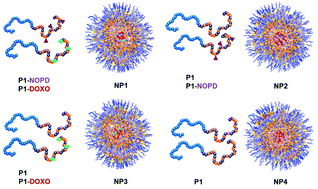当前位置:
X-MOL 学术
›
Biomater. Sci.
›
论文详情
Our official English website, www.x-mol.net, welcomes your feedback! (Note: you will need to create a separate account there.)
Enhancing doxorubicin anticancer activity with a novel polymeric platform photoreleasing nitric oxide.
Biomaterials Science ( IF 6.6 ) Pub Date : 2020-01-08 , DOI: 10.1039/c9bm01644a Federica Sodano 1 , Robert J Cavanagh , Amanda K Pearce , Loretta Lazzarato , Barbara Rolando , Aurore Fraix , Thais F Abelha , Catherine E Vasey , Cameron Alexander , Vincenzo Taresco , Salvatore Sortino
Biomaterials Science ( IF 6.6 ) Pub Date : 2020-01-08 , DOI: 10.1039/c9bm01644a Federica Sodano 1 , Robert J Cavanagh , Amanda K Pearce , Loretta Lazzarato , Barbara Rolando , Aurore Fraix , Thais F Abelha , Catherine E Vasey , Cameron Alexander , Vincenzo Taresco , Salvatore Sortino
Affiliation

|
Combinations of conventional chemotherapeutics with unconventional anticancer agents such as reactive oxygen and nitrogen species may offer treatment benefits for cancer therapies. Here we report a novel polymeric platform combining the delivery of Doxorubicin (DOXO) with the light-regulated release of nitric oxide (NO). An amphiphilic block-copolymer (P1) was designed and synthesized as the drug carrier, with pendant amine groups to attach DOXO via a urea linkage and a NO photodonor (NOPD) activable by visible light. The two grafted-copolymers (P1-DOXO and P1-NOPD) self-assembled via solvent displacement methods into nanoparticles (NPs), containing both therapeutic components (NP1) and, for comparison, the individual NOPD (NP2) and DOXO (NP3). All the NPs were fully characterized in terms of physicochemical, photochemical and photophysical properties. These experiments demonstrated that integration of the NOPD within the polymeric scaffold enhanced the NO photoreleasing efficiency when compared with the free NOPD, and that the proximity to DOXO on the polymer chains did not significantly affect the enhanced photochemical performance. Internalization of the NPs into lung, intestine, and skin cancer cell lines was investigated after co-formulation with Cy5 fluorescent tagged polymers, and cytotoxicity of the NPs against the same panel of cell lines was assessed under dark and light conditions. The overall results demonstrate effective cell internalization of the NPs and a notable enhancement in killing activity of the dual-action therapeutic NP1 when compared with NP2, NP3 and the free DOXO, respectively. This suggests that the combination of DOXO with photoregulated NO release, achieved through the mixed formulation strategy of tailored polymer conjugate NPs, may open new treatment modalities based on the use of NO to improve cancer therapies.
中文翻译:

用新型的聚合物平台光释性一氧化氮增强阿霉素的抗癌活性。
常规化学疗法与非常规抗癌药(例如活性氧和氮物质)的组合可为癌症治疗提供治疗益处。在这里,我们报告了一个新颖的聚合平台,结合了阿霉素(DOXO)的传递与一氧化氮(NO)的光调节释放。设计并合成了两亲嵌段共聚物(P1)作为药物载体,其侧链胺基通过尿素键连接DOXO并通过可见光激活NO光电给体(NOPD)。两种接枝共聚物(P1-DOXO和P1-NOPD)通过溶剂置换法自组装成纳米颗粒(NPs),既包含治疗成分(NP1),又包含单独的NOPD(NP2)和DOXO(NP3),以作比较。所有NP均已根据理化特性进行了充分表征,光化学和光物理性质。这些实验表明,与游离的NOPD相比,将NOPD整合到聚合物支架中可以提高NO的光释放效率,并且聚合物链上DOXO的接近性不会显着影响增强的光化学性能。在与Cy5荧光标记聚合物共配制后,研究了NPs在肺,肠和皮肤癌细胞系中的内化作用,并在黑暗和明亮条件下评估了NPs对同一组细胞系的细胞毒性。总体结果表明,分别与NP2,NP3和游离DOXO相比,NPs的有效细胞内在化和双效治疗性NP1的杀伤活性显着增强。
更新日期:2020-03-03
中文翻译:

用新型的聚合物平台光释性一氧化氮增强阿霉素的抗癌活性。
常规化学疗法与非常规抗癌药(例如活性氧和氮物质)的组合可为癌症治疗提供治疗益处。在这里,我们报告了一个新颖的聚合平台,结合了阿霉素(DOXO)的传递与一氧化氮(NO)的光调节释放。设计并合成了两亲嵌段共聚物(P1)作为药物载体,其侧链胺基通过尿素键连接DOXO并通过可见光激活NO光电给体(NOPD)。两种接枝共聚物(P1-DOXO和P1-NOPD)通过溶剂置换法自组装成纳米颗粒(NPs),既包含治疗成分(NP1),又包含单独的NOPD(NP2)和DOXO(NP3),以作比较。所有NP均已根据理化特性进行了充分表征,光化学和光物理性质。这些实验表明,与游离的NOPD相比,将NOPD整合到聚合物支架中可以提高NO的光释放效率,并且聚合物链上DOXO的接近性不会显着影响增强的光化学性能。在与Cy5荧光标记聚合物共配制后,研究了NPs在肺,肠和皮肤癌细胞系中的内化作用,并在黑暗和明亮条件下评估了NPs对同一组细胞系的细胞毒性。总体结果表明,分别与NP2,NP3和游离DOXO相比,NPs的有效细胞内在化和双效治疗性NP1的杀伤活性显着增强。



























 京公网安备 11010802027423号
京公网安备 11010802027423号